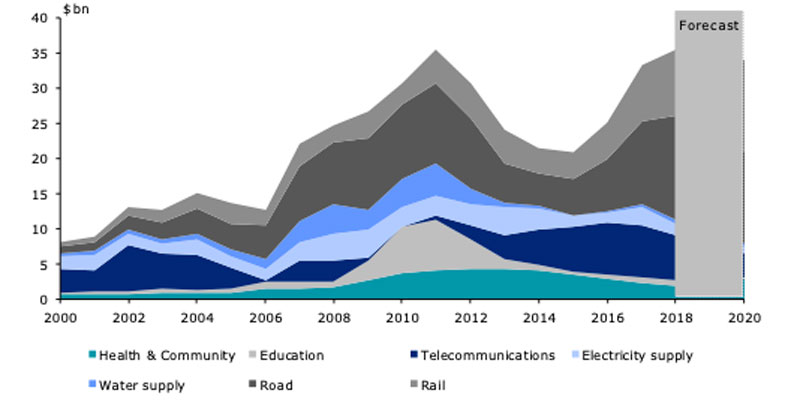Infrastructure Spending Set to Peak: Deloitte
Infrastructure spending looks set to retreat over the next two years with the culmination of a number of major transport projects.
Infrastructure spending, which will reach a peak of almost $40 billion in 2019, was originally projected to lift sharply, a prediction which has since been downgraded.
Deloitte Access Economic's review of the investment outlook noted the factors that had driven the burst of infrastructure activity were beginning to wane with fewer assets left to privatise, and the slowing housing market weighing on property tax collections.
“Although the healthy project pipeline will continue to support elevated levels of infrastructure activity, we expect calendar year 2019 to be the peak for this cycle,” Deloitte Access Economics partner Stephen Smith said.
Related: Keep Up: Infrastructure Failing to Keep Pace with Demand for Housing
Infrastructure investment by sector

The value of projects either under construction or with firm commitments fell by 24 per cent to $263 billion over last year, with a number of high profile projects completing.
Major investment projects both under construction and planned dropped to a 10-year low falling by fell by $27 billion to $679 billion, a 0.9 per cent decrease from the previous quarter.
The value of planned projects also decreased by $9 billion over the quarter.
The report highlighted that the impending NSW state election, scheduled for March, could result in further projects.
A number of large NSW projects, such as the $8.3 billion Sydney Metro Northwest are scheduled to wrap up in 2019, while others such as the $4.9 billion Pacific Highway upgrade from Woolgoolga to Ballina, the $3 billion NorthConnex, and the $2.1 billion Sydney CBD light rail are expected to be complete in 2020.
There are already another $75 billion in transport projects being actively considered, with a further $57 billion in projects considered possible.
Deloitte expects growth in both government and private investment to be relatively flat both this year and next, before gathering momentum.
Related: Australia's Construction Pipeline is Worth $25bn
Late last year, the release of the Planning Liveable Cities report recommended substantial planning, funding and policy reforms in order for infrastructure spending and construction to keep pace with Australia's new housing in growth areas.
It is estimated Australia’s population is projected to increase by more than 10 million people between 2017 and 2047, with 80 per cent of this growth concentrated in Australia’s five largest cities.
“Around the country, governments are structured to deliver outcomes for sectors, such as transport, education, and health services, rather than outcomes for a ‘place’ and a community,” Infrastructure Australia executive director Peter Colacino said in relation to the report released in December.
“This can lead to siloed planning and decision-making, which often leads to poor outcomes for communities.”















